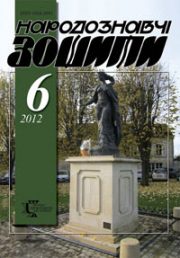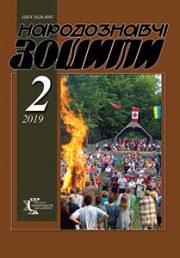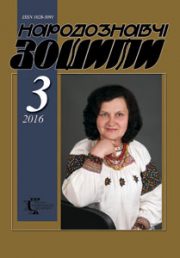The Ethnology Notebooks. 2023. № 6 (174), 1437—1449
UDK [398.4+392/393:27-528.5](=1:6-15):001.891Ю.Шумовський
DOI https://doi.org/10.15407/nz2023.06.1437
LYTVYN Mykola
- ORCID: https://orcid.org/0000-0003-1010-2329
- ResearcherID: C-1385-2019 (http://www.researcherid.com/rid/C-1385-2019)
- Professor, Head of the Center for Ukrainian-Polish researches, Ivan Krypiakevych Institute of Ukrainian Studies, 4 Kozelnyts’ka, 79026 , Ukraine
- Contacts: e-mail: lytvynmr@gmail.com
TARAS Yaroslav
- ORCID ID: https://orcid.org/0000-0001-7241-9466
- Doctor of Historical Sciences, Professor,
- Institute of Ethnology of the National Academy of Sciences of Ukraine,
- Head of the modern ethnology department,
- 15, Svobody Avenue, 79000, Lviv, Ukraine;
- Professor,
- Lviv Polytechnic National University,
- department of architecture and design,
- 12, Bandera street, 79013, Lviv, Ukraine,
- Contacts: e-mail: etnomod@ukr.net
Abstract. The article is based on the elaborated work of Yu. Shumovsky, analyzes the materials devoted to the system of religious beliefs and ritual traditions of West African tribes, which is represented by the development and practice of maternity (observance of ancient customs) and funeral rituals (places and methods of burial, specifics of the funeral ceremony) worship of plants (combination of symbols and meanings of the healing and miraculous properties of certain representatives of the flora), animals (honoring the mythological creature of the snake – area of distribution and history of origin), natural elements (a variety of rituals associated with water spirits), beliefs (in the afterlife of the soul,beliefs (in the afterlife of the soul, afterlife), rituals (circumcision, excision — as an important element of the religious practice of African peoples).
The novelty of the publication is the introduction into scientific circulation of previously unpublished materials about the traditional-customary system of West African tribes collected by the Ukrainian scientist Yury Shumovsky.
The purpose of the article is to highlight research by scientists into the system of religious beliefs and ritual traditions of West African tribes.
The source base is materials from the scientific heritage of Yuriy Shumovsky, contained in the funds of the State Historical and Cultural Reserve of Dubno.
The methodological basis of the article is the principle of systematization, thanks to which new inferential knowledge about the level of development of life and culture of representatives of ancient African culture is formulated.
The ritual-magical aspect in the reproduction of ritual actions at the level of three components «animism» – «religion» – «magic» is outlined, in the basis of which the role of the main performer of the human magician – the «African magician» is highlighted. It was established that the presence of all the described elements of magical beliefs and rituals is a determining indicator of the formation of African peoples’ own value system, which emphasizes their originality and identity.The importance of introducing into the scientific circulation the results of the study of the scholar’s works of the African period, which will contribute to the proper presentation of the figure of Yu. Shumovsky as an «Africanist» and the highlighting of the traditional-customary system of the tribes of West Africa, is determined.
Keywords: West Africa, Yuri Shumovsky, animism, fetishism, magic, African wizard, beliefs, rites, rituals, worship.
Received 30.10.2023
REFERENCES
- Szumovsky, G. Scientific and administrative documents on the archaeological work of Yu. Shumovsky in Africa. Funds of the State Historical and Cultural Reserve of Dubno. KN 6535/D 3817. Arc. 1—100 [in French].
- Szumowski, G. (1972, 12 October). Relevence of African culture. Seawanhaka (P. 7). Brooklyn.
- Szumovsky, G. Scientific journalistic work of Fr. Dr. Prof. Yuri Shumovsky as an archaeologist and correspondent of the United Nations. Funds of the State Historical and Cultural Reserve of Dubno. KN 6533/D 3815. Arc. 1—81 [in French].
- Szumovsky, G. (1956). Under the hot sun of Africa. Winnipeg [in Ukrainian].
- Szumovsky, G. (1989). In the footsteps of the ancient past of Africa. New York. Funds of the Rivne Regional Museum of Local Lore. RKM 15517. Dop. arc. 789 [in Ukrainian].
- Szumovsky, G. (1963, April 30). The peoples of Africa and their struggle for independence. Freedom, 80, 2 [in Ukrainian].
- Szumovsky, G. (1964, January 17). Woman of the Black Continent. Freedom, 11, 2 [in Ukrainian].
- Szumovsky, G. (1964, June 30). Union of African Nations. Freedom, 120, 2 [in Ukrainian].
- Szumovsky, G. (1965, 26 October). African press. Freedom, 199, 2 [in Ukrainian].
- Szumovsky, G. (1965, June 24). The Maghreb country. Freedom, 118, 2 [in Ukrainian].
- Szumovsky, G. (1965, 2 September). The problem of national language in Black Africa. Freedom, 162, 2 [in Ukrainian].
- Szumovsky, G. (1976, April 15). Red threat to Africa. Freedom, 71, 2 [in Ukrainian].
- Szumovsky, G. (1962). The cult of snakes in the peoples of Africa. New Dawn, 8252, 4 [in Russian].
- Szumovsky, G. (1962, March 24). Secrets of African caves. New Dawn (P. 3). San Francisco [in Russian].
- Szumovsky, G. (1962, March 9). In the footsteps of the ancient empire of Ghana. New Dawn (P. 4). San Francisco [in Russian].
- Szumovsky, G. (1964, February 1). Africa on fire. America, 22, 33. Funds of DIKZ of Dubno. CN 6533/D3815 [in Ukrainian].
- Szumovsky, G. (1961, January 15). Prehistoric man of West Africa. Novye Russkoe Slovo (P. 2). New York [in Russian].
- Szumovsky, G. (1953). Mask in the moray eels of Africa. We and the world, 11, 51—54 [in Ukrainian].
- Szumovsky, G. (1956). The cult of plants in the moray eels of Africa. We and the world, 31, 11—13 [in Ukrainian].
- Szumovsky, G. (1956). From my life in Sudan. We and the world, 29, 20—26 [in Ukrainian].
- Szumovsky, G. (1956). From my life in Sudan. We and the world, 30, 10—14 [in Ukrainian].
- Szumovsky, G. (1952). In the middle of the jungle and the shroud. We and the world, 8, 41—44 [in Ukrainian].
- Szumovsky, G. (1964). Ba Faro. Ovid, 2 (129), 43—48 [in Ukrainian].
- Szumovsky, G. (1954). Excavations at Fatoma (Mopni region, Sudan). African Notes. French Institute of Black Africa, 6, 102—108 [in French].
- Szumovsky, G. (1953). Notes on the prehistoric cave of Bamako. Bull of IFAN, 58, 35—40 [in French].
- Szumovsky, G. (1953). Notes on the prehistoric cave of Bamako. Bull of IFAN, 66, 673—680 [in French].
- Szumovsky, G. (1955). Excavations at Kami and discoveries in the Mopti region (Sudan). African Notes. French Institute of Black Africa, 67, 65—69 [in French].
- Szumovsky, G. (1956). Excavations at Nantaka and Kelebere. African Notes. French Institute of Black Africa, 70, 33—38 [in French].
- Szumovsky, G. (1956). Notes on Sudanese Neolithic hashes. Bull of IFAN. French Institute of Black Africa. Africans, 72, 98—102 [in French].
- Szumovsky, G. (1956). Prehistoric remains in the Bandiagara region. French Institute of Black Africa. Africans, 69, 19—23 [in French].
- Szumovsky, G. (1956). Excavations of Kourounkorokale rock shelter (French Sudan). Bulletin of the French Institute of Black Africa. Social science, 3—4 (Vol. 18, pp. 462—508) [in French].
- Szumovsky, G. (1956). On a rock engraving from Niger in Bamako. Bull of IFAN. Bulletin of the French Prehistoric Society, 11—12 (Vol. 52, pp. 651—654). Paris [in French].
- Szumovsky, G. (1957). Excavations north of Macina and in the region of Segou. Bulletin of the French Institute of Black Africa. Social science, 1—2 (Vol. 19, pp. 224—508) [in French].
- Szumovsky, G. (1954). The archaeological richness of the caves of Sudan. French Sudan (Pp. 1—2). Paris [in French].
- Szumovsky, G. (1972, 12 October). Relevence of African culture. Seawanhaka (P. 7). Brooklyn.
- Szumovsky, G. (1971, 4 November). Primitive man as sorcerer, magician. Seawanhaka (Pp. 7—8). Brooklyn.







